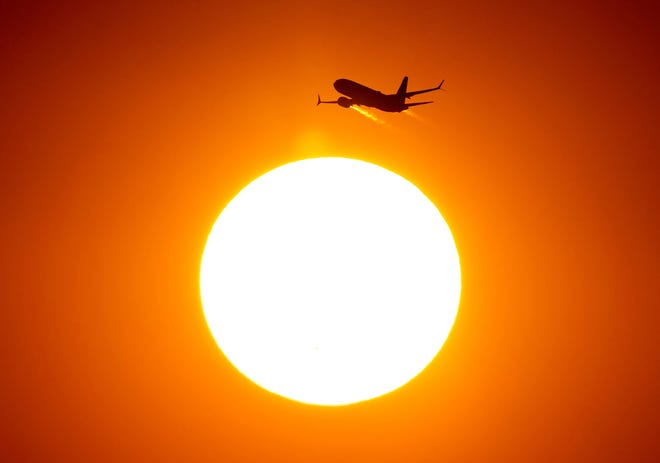- Approximately two-thirds of flight delays are caused by weather.
- Extreme heat can make flying impossible.
- The safest option is to take the first flight in the morning.
As temperatures rise, disruptions to air travel are on the way.
Summer is a busy travel season, but it also brings unpredictable weather and travel delays that are beyond the airlines’ control.
This unpredictability of flying is due to two main factors: more frequent storms and, in extreme cases, high temperatures that can prevent some planes from taking off or landing.
High temperatures can make you feel uncomfortable while you wait to board your flight.
With summer fast approaching, here’s what to expect when it comes to air travel and weather.
Nearly two-thirds of flight cancellations are due to weather
According to the Federal Aviation Administration, 63% of flight delays are due to weather.
“The FAA’s job is to get travelers to their destinations safely and efficiently. This summer will see more planes in the skies, more frequent severe weather and increased use of the nation’s airspace. We are continually working to meet these challenges,” the agency said in a statement. “Our summer travel website describes the efforts we’ve taken to keep summer traffic safe and running smoothly.”
The airline’s southern hubs are especially vulnerable to disruptions caused by storms and extreme heat in the summer.
“While we cannot control weather, which is the number one cause of delays, we plan for and respond to convective conditions,” FAA Administrator Mike Whitaker said in a statement. “To improve safety and enhance the efficient operation of runways, we are deploying innovative new ground surveillance technology at airports across the nation.”

Extreme heat makes flying impossible
As global temperatures rise, storms aren’t the only thing that will affect flying.
“When air heats up, it becomes less dense because the air molecules spread out,” Bob Thomas, an assistant professor of aeronautical sciences at Embry-Riddle University in Daytona Beach, said in a post on the school’s website. “Hot air is thin air. This reduces the lift that planes rely on to take off, but the main effect is felt in the engine thrust. As a result, plane engines have less thrust during takeoff and climb.” That makes takeoff more difficult, and sometimes impossible.
High temperatures may cause some airports to impose stricter weight restrictions on some planes, forcing some passengers to not board. Extreme temperatures may also cause airlines to cancel some flights altogether.
Cruising altitude:Has your flight been delayed or cancelled? How can you proactively prepare for it?
How hot is too hot for an airplane?
Most Airbus and Boeing mainline jets can safely take off at angles up to about 122 degrees — smaller regional jets often have lower standards for safe operation — but the exact limit depends on a variety of factors, including the plane’s total weight, the airport’s altitude and other conditions.

How to plan ahead
Your safest bet is to catch the first flight in the morning, when temperatures are at their coldest and airlines are least likely to experience cascading delays from previous disruptions.
Also, if possible, it’s a good idea to avoid connecting at airports that are more susceptible to summer weather delays. A good rule of thumb is to connect at northern airports in the summer and southern airports in the winter.
Zach Wichter is a New York-based travel writer for USA TODAY. He can be reached at zwichter@usatoday.com.

